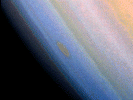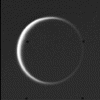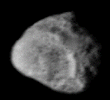
 Saturn
Saturn

Planet Profile
Mass (kg)............................................5.69 x 10^26
Diameter (km)........................................120660
Mean density (kg/m^3) ...............................690
Escape velocity (m/sec)..............................35600
Average distance from Sun (AU).......................9.539
Rotation period (length of day) (in Earth hours).....10.2
Revolution period (length of year) (in Earth years)..29.46
Obliquity (tilt of axis) (degrees)...................26.7
Orbit inclination (degrees)..........................2.49
Orbit eccentricity...................................0.056
Mean temperature (K).................................88 K (1 bar level)
Visual geometric albedo..............................0.46
Atmospheric components...............................97% hydrogen,
3% helium,
.05% methane
Rings................................................Rings are
270,000 km in diameter, but only a few hundred meters thick.
Particles are centimeters to decameters in size and are ice (some
may be covered with ice); there are traces of silicate
and carbon minerals. There are four main ring groups and three
more faint, narrow ring groups separated by gaps called divisions.

 Clouds and Spokes
Clouds and Spokes
Several dark spoke-like features, like those indicated by the arrows,
can be seen across the broad B ring (left of planet). The moons Rhea
and Dione appear as dots below and below left of Saturn,
respectively. This photo was taken July 21, 1981, when the spacecraft
was 33.9 million km (21 million mi) from the planet. Voyager 2 made its
closest approach to Saturn on August 25, 1981.
 Rings in Shadow
Rings in Shadow
This image of Saturn was taken while the spacecraft was departing the
Saturnian system. The planet's disk casts a shadow across the ring
system. The visible side of the rings is directly illuminated by the
sun. The broad dark band in the rings separates the outer A ring from
the inner B ring. The C ring is much fainter and closer to the planet.
The narrow F ring is just barely visible outside the A ring.
 Braided Rings
Braided Rings
Saturn's narrow F ring, just outside the main ring system, is a very
complex structure. In this close-up view it is made up of two narrow
bright rings and a fainter ring inside them. The bright rings contain
bends, kinks, and bright clumps that give the illusion that these
strands are braided. Scientists speculate that the clumps may contain
mini moons. The F ring was photographed at a range of 750,000 km
(470,000 mi).
 Red Oval Cloud
Red Oval Cloud
This unique red oval cloud feature is visible in Saturn's southern
hemisphere. The difference in color between the red oval and
surrounding bluish clouds indicates that material within the oval
contains a substance that absorbs more blue and violet light than the
bluish clouds. The oval feature did not change in appearance for
several months before this photo was taken on November 6, 1980 at a
distance of 8,500,000 km (6,300,000 mi).
 Three Moons
Three Moons
The disk of Saturn casts a shadow across its rings away from the
sun. The satellites Mimas, Enceladus, and Tethys, seen as dots, all
orbit Saturn in the plane defined by its rings and equator.
 Saturn's Moons
Saturn's Moons
Saturn and two of its moons, Tethys and Dione, were photographed by
Voyager 1 at a distance of 13 million km (8 million mi). The shadows of
Saturn's three bright rings are cast onto the cloud tops. The limb of
the planet can be seen easily through the 3500 km (2170 mi) wide
Cassini Division, which separates the A and B rings. The view through
the much narrower Encke Gap, near the outer edge of the A ring is less
clear. Closer to the planet is the faintest of Saturn's three main
rings, the C ring or crepe ring, barely visible against the planet.
 Cataclysmic Impact
Cataclysmic Impact
Mimas, the innermost of Saturn's larger moons, was nearly shattered by
a cataclysmic impact. From observing Mimas' crater Herschel, scientists
speculate that the inner satellites of the outer planets have, in fact,
been shattered and gravitationally reassembled many times in their
geologic history. Herschel's walls are approximately 5 km (3.2 mi)
high, parts of its floor measure 10 km (6.2 mi) deep, and its central
peak rises 6 km (3.7 mi) above the crater floor. The diameter of this
moon is 394 km (244 mi).
 Global Mosaic
Global Mosaic
This global mosaic of Enceladus was assembled from images acquired by
Voyager 2 during its close flyby of Saturn's second large
satellite. Although Enceladus shows an abundance of impact craters in
some areas, the lava flows near the center of the disk contain many
fewer craters and cut some craters in half. This confirms the multiple
stages or episodes of volcanism that formed and reformed the icy body's
surface.
 Bright Satellite
Bright Satellite
The surface of Enceladus resembles that of Jupiter's satellite
Ganymede. Some areas are smooth and uncratered while others contain
impact craters up to 35 km (22 mi) in diameter. Linear sets of grooves
tens of kilometers long traverse the surface and are probably faults
resulting from deformation of the crust. The uncratered regions are
geologically young and may indicate that Enceladus has experienced a
period of relatively recent internal melting. The satellite is about
500 km (310 mi) in diameter and has the brightest surface of any of
Saturn's satellites.
 Impact Craters
Impact Craters
Tethys is approximately 1100 km (684 mi) in diameter and is densely
populated with impact craters. One of these, above center, is
surrounded by a hummocky ejecta blanket. Ithaca Chasma stretches from
left center up toward the crater, covering three quarters of the
circumference of Tethys.
 Smooth Crust
Smooth Crust
In this image of Saturn's fourth large moon, Dione, the trailing
hemisphere is visible. This region was protected from billions of years
of impact-gardening, which obliterated old surface features in the
leading hemisphere. Icy fluids escaped to the surface through breaks in
the crust and formed giant crisscrossing, wispy, bright marks on the
exterior.
 Full Disk
Full Disk
Impact craters are visible records of the collision of cosmic
debris. On Dione, the largest crater is less than 100 km (62 mi) in
diameter and shows a well-developed central peak. The sinuous valleys
may have formed when faults broke the moon's icy crust. Images in this
mosaic were taken from a range of 162,000 km (100,600 mi) on November
12, 1980.
 Water Ice
Water Ice
The density of this satellite suggests that it is largely made of water
ice with a small proportion of rocky material. Note that the ancient
impact scars that ripped through the ice early after the formation of
the solar system are still preserved to this day.
 Obscure Titan
Obscure Titan
This view of Saturn's largest satellite was taken from a position
looking almost directly back toward the sun at the Mercury-sized
body. Titan's hydrocarbon-rich nitrogen atmosphere scatters sunlight in
a forward direction over the limb around the entire disk. The surface
of Titan is obscured due to a deep cloud layer. The diameter of Titan
is 5150 km (3200 mi).
 Irregular Body
Irregular Body
Scientists believe that this small irregular satellite may once have
been a piece of a larger satellite. Hyperion measures approximately 370
x 280 x 225 km (229 x 174 x 140 mi) and orbits outside of Titan.
 Global Dichotomy
Global Dichotomy
The leading hemisphere of Iapetus is covered by extremely dark
material, whereas the trailing hemisphere is covered with bright
material. This dichotomy puzzled the discoverer, astronomer Giovanni
Cassini, who noted that the satellite was visible only from one side of
its orbit. Two models have been proposed to explain this. The first
proposes that dark material from Phoebe, a dark exterior moon, falls
onto Iapetus from orbit. The second model says that the dark material
erupted from the interior of Iapetus into a low area in the leading
hemisphere.

 Welcome to the Planets Home Page
Welcome to the Planets Home Page


 Saturn
Saturn

 Clouds and Spokes
Clouds and Spokes  Rings in Shadow
Rings in Shadow  Braided Rings
Braided Rings  Red Oval Cloud
Red Oval Cloud  Three Moons
Three Moons  Saturn's Moons
Saturn's Moons  Cataclysmic Impact
Cataclysmic Impact  Global Mosaic
Global Mosaic  Bright Satellite
Bright Satellite  Impact Craters
Impact Craters  Smooth Crust
Smooth Crust  Full Disk
Full Disk  Water Ice
Water Ice  Obscure Titan
Obscure Titan  Irregular Body
Irregular Body  Global Dichotomy
Global Dichotomy 